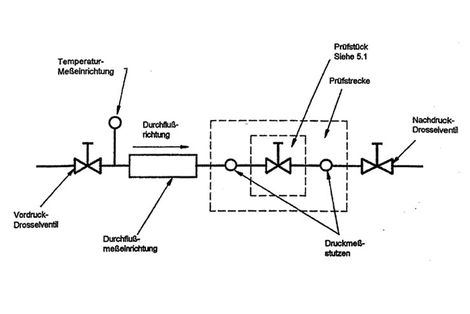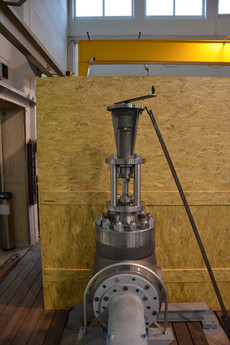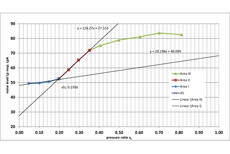Measurements of DN150/DN200 control valves
Contents of this project which resulted from an order placed by an international holding were measurements regarding the cavitation behaviour of control valves as well as the acoustic impact of the occurring cavitation. All measurements and tests were realised on the Institute’s test rig whereas for the acoustic measurements according to IEC 60534-8-2 an auxiliary noise-reduced housing was installed.
These measurements aimed at the evaluation of the /flow resistance dependent of the pre-set position of a defined valve. This so-called kv-value is being measured under stationary conditions with the test medium water according to IEC 60534-2-3 and then calculated as of the flow rate or pressure difference. The Institute’s test rig enables us to measure and test rather large valves conforming to standards. Furthermore, maximum flow rates of more than 300 l/sec and pressure differences of more than 8 bar could be realised for this measurement campaign.
These significant volumes and/or pressures were necessary to trigger cavitation within the valve and thus depict behaviour under choked flow conditions. This choked flow state caused by maximum/total cavitation is important for the assessment of maximum flow rate and/or choked flow conditions caused by cavitation in real-life operation.
Apart from cavitation measurements based on flow rate and pressure difference, the cavitation behaviour could also be assessed by means of acoustic measurements as a sharply increasing acoustic level is an unmistakeable sign that cavitation occurs. In future, simple on-site acoustic measurements in plants and calculations based on the determined xFZ parameter will enable the definition of the capacity and operation mode of a certain valve and thus contribute to increased plant safety.
Core competences
Standards & norms
- IEC 60193: Hydraulic turbines, storage pumps and pump-turbines – Model acceptance tests
- IEC 60534: Industrial-process control valves
- ISO 9906: Rotodynamic pumps – Hydraulic performance acceptance tests
- IEC 60041: Field acceptance tests to determine the hydraulic performance of hydraulic turbines, storage pumps and pump-turbines
- IEC 62006: Hydraulic machines – Acceptance tests of small hydroelectric installations
The list above is an excerpt. For the fulfillment of other standards please contact us.







